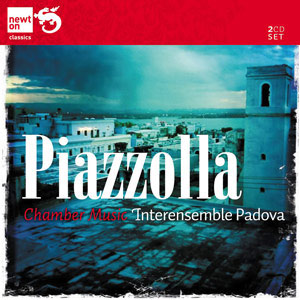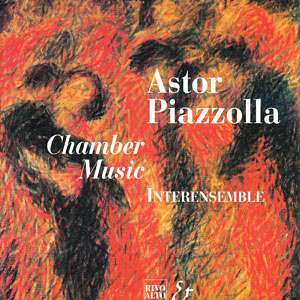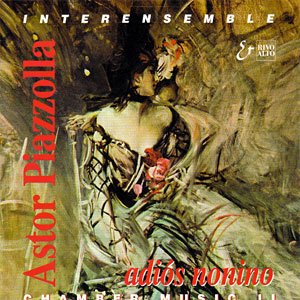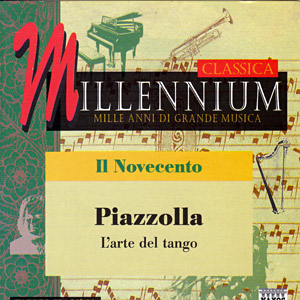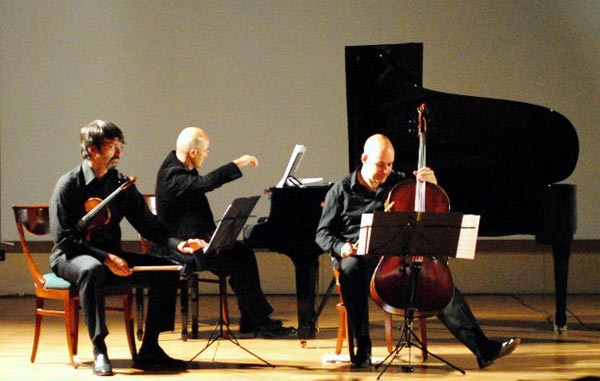The history of a passion. The recordings dedicated to the Argentinian maestro.
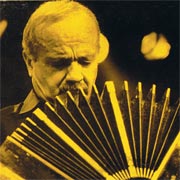 From March 1987 to December 2020, Interensemble gave 75 concerts with music by Astor Piazzolla. The long and constant association with the music of the great Argentinian musician was therefore much more than a performing and recording project. It was something that became a more intimate part of Interensemble’s history. In fact, the 1985 release of the film Tangos – L’exil de Gardel by Fernando Solanas - the beautiful soundtrack of which was written by Piazzolla and performed by his historic Quintet - was a kind of rediscovery of the Nuevo Tango that had already been heard in previous years transmitted during Studio Uno’s Saturday evening of Radiotelevisione Italiana. And the more attentive will have remembered that sensual and dramatic music, played by a bizarre group of Argentinian tanguéros, the leader of which performed on a strange accordion, the bandoneòn. Was it pop or folk music, or were we dealing with some kind of Jazz? It was music that was fascinating, full-blooded and languid at the same time, abhorred however, by contemporary music festivals at the time.
From March 1987 to December 2020, Interensemble gave 75 concerts with music by Astor Piazzolla. The long and constant association with the music of the great Argentinian musician was therefore much more than a performing and recording project. It was something that became a more intimate part of Interensemble’s history. In fact, the 1985 release of the film Tangos – L’exil de Gardel by Fernando Solanas - the beautiful soundtrack of which was written by Piazzolla and performed by his historic Quintet - was a kind of rediscovery of the Nuevo Tango that had already been heard in previous years transmitted during Studio Uno’s Saturday evening of Radiotelevisione Italiana. And the more attentive will have remembered that sensual and dramatic music, played by a bizarre group of Argentinian tanguéros, the leader of which performed on a strange accordion, the bandoneòn. Was it pop or folk music, or were we dealing with some kind of Jazz? It was music that was fascinating, full-blooded and languid at the same time, abhorred however, by contemporary music festivals at the time.
We however, performed straightaway in August 1987 during the Music Festival in Old Krakow, and Polish Radio recorded and broadcast it soon after. Then, on the occasion of a concert given by his Quintet, there was our first meeting with Astor in Padua, during which I asked him if we could have copies of his original chamber music. The scores arrived almost straightaway from the editor Lemoine - Four for Tango, Histoire du Tango and Trois Preludes – all pieces composed and printed recently. And from Argentina, the editor Lagos sent us several less recent pieces, including the beautiful Cuatro Estaciones and the celebrated Oblivion transcribed for trio by his trusted cellist José Bragato. But also obscure pieces arrived that nobody knew of, such as the Tango in La and Tres Piezas Breves, that were composed as long ago as the Forties. So piece after piece, there developed a passion in all members of the group for one of the greatest composers of the twentieth century, but not yet admitted to the so-called “temple of classical music”. There then followed the recordings, first for Rivoalto, then for Naxos and Newton Classics, then new pieces to add to the repertory and the setting of Borges’ texts to music. In the meantime, Piazzolla’s music became so popular that it was even “used” in many television advertisements. Because, as my friend, the Argentinian pianist Hugo Aisemberg said: “Piazzolla’s music is always beautiful, even when played on a ukulele”.
B. Beggio. From Interensemble 3.0 – About its thirty years





